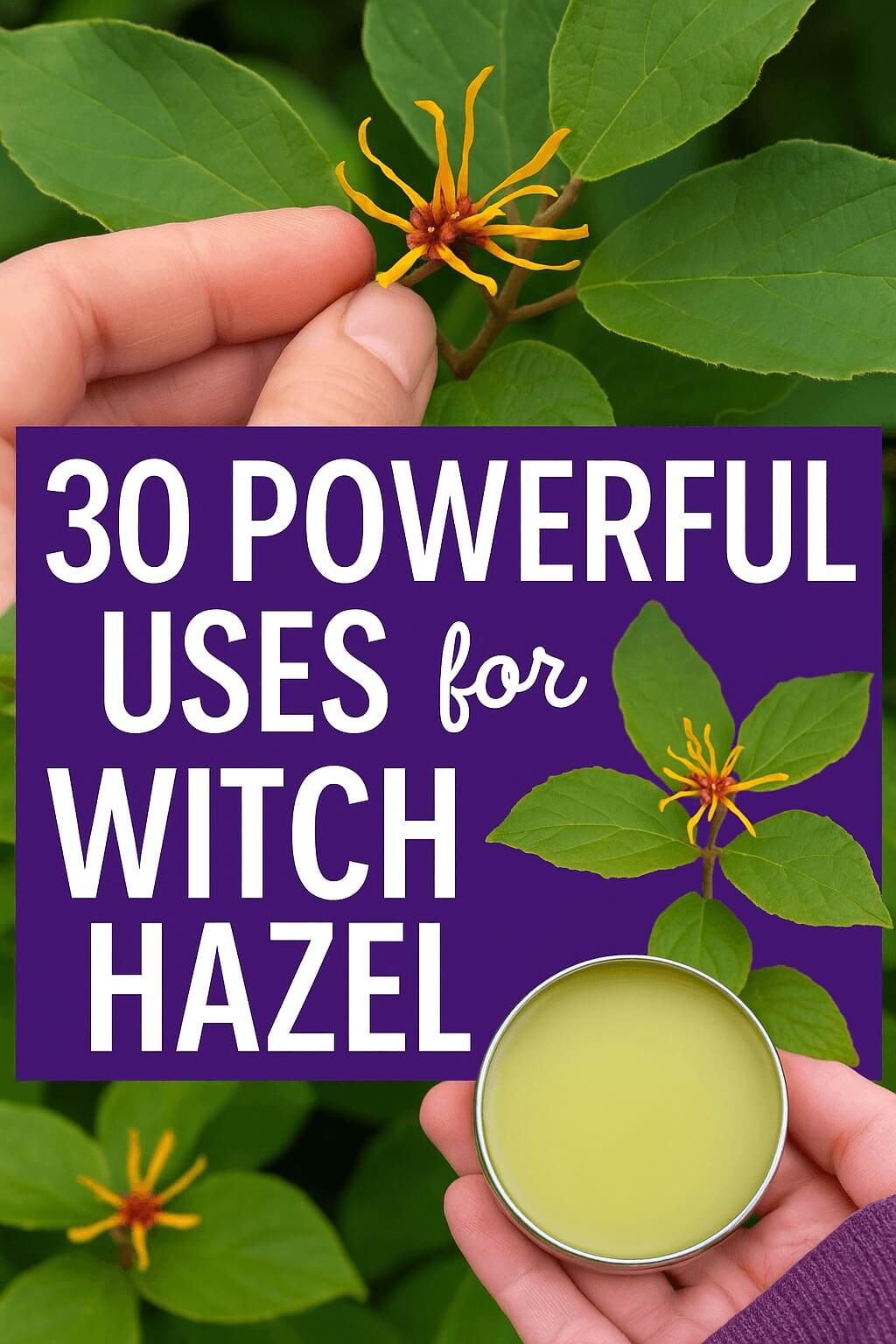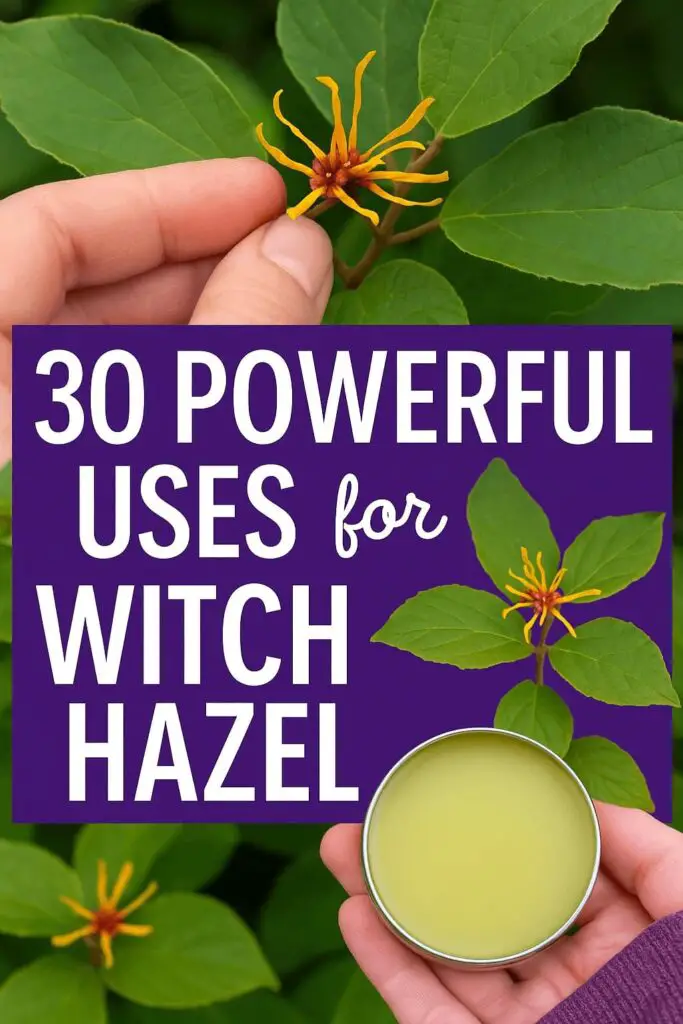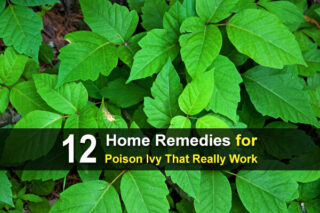Estimated reading time: 8 minutes
Disclaimer: I am not a medical doctor and nothing in this article should be taken as medical advice. Please talk to your doctor before using any of the herbs and/or remedies mentioned in this article.
Witch hazel is an amazing yet little-known plant that, when turned into a topical astringent, has numerous uses. If you are new to the world of natural medicine, you may not have heard of this little gem.
If you have heard of it, you may be a little put off by the name. Or maybe you remember your grandma using it to fix an owie when you were little, but haven't really seen or heard much about it since.
The fact is, witch hazel is one of the best-kept secrets in the world of natural medicine and old folk remedies. What is it, you ask? Well, it is an astringent. Yes, the facial toners and cleansers you pay a small fortune for at the store are astringents. An astringent is a go-to remedy for a variety of skin ailments, but the uses don't stop there.
Once you realize how useful and beneficial witch hazel is, you will want to start keeping it on your shelf. Another very lucrative reason to stockpile witch hazel is the price. It is very cheap compared to other commercial medicines. When you can get one item that takes the place of 20 or more, doesn't it make sense to go with that single item?
Before diving into the list, it’s helpful to understand some key science behind witch hazel.
Want to save this post for later? Click Here to Pin It On Pinterest!
Why Witch Hazel Works
- Witch hazel comes from Hamamelis virginiana, a shrub native to North America. Native American healers long used decoctions of bark and leaves to treat inflammation, swelling, wounds, and irritation.
- Its efficacy is largely tied to tannins, polyphenols, and flavonoids, which act as astringents, antioxidants, and mild anti-inflammatory agents.
- A recent study found that a novel witch hazel formula significantly reduced inflammatory markers (like IL‑6 and IL‑8) and improved skin barrier integrity in UV‑induced stress models.
- Another review notes that witch hazel extracts may help in skin conditions such as eczema, psoriasis, razor burn, and general irritation.
- On the downside, although witch hazel is generally safe topically, it can sometimes cause skin irritation, dryness, or contact dermatitis, especially in sensitive skin.
- Oral consumption of witch hazel is much more risky. Large doses may cause stomach upset, and there is limited evidence for safe internal use.
Given its benefits and risks, witch hazel is best viewed as a versatile tool in your herbal kit, not a cure-all. Use with discretion, especially if you have sensitive skin or existing skin disorders (like rosacea).
With that said, here are 30 uses for witch hazel:
1. Acne
Acne doesn't stand a chance against a little dab of witch hazel. Put some on a cotton ball and dab at the first sign of a pimple. It will dry it up quickly. You can also use witch hazel as a nightly face wash to help prevent acne.
2. Bags Under Eyes
For those who carry enough luggage under their eyes to take a two-week vacation, witch hazel is the answer. Rub a little under the eyes and over the bags, and you will seem them slowly fade away.
3. Bleeding Gums
Bleeding and receding gums can actually lead to some serious dental problems. Rinsing the mouth with a little witch hazel every night can help stop the bleeding, reduce the swelling, and make the gums feel better in general.
4. Bruises
If you have a nasty bruise that you want to fade quickly, rubbing witch hazel on it every day will help speed up the healing.
5. Bug Bites
If you are dealing with bug bites, a little witch hazel can stop the itching and burning almost instantly. This will work on mosquito bites as well.
6. Bugs
Witch hazel is an excellent bug repellent when you add a few drops of peppermint essential oil. This can help prevent the need for a bug bite remedy!
7. Chickenpox
Contracting chickenpox is rare these days, but you can help stop the itching and painful blisters with an application of witch hazel This means less scratching, which means less scarring.
8. Cold Sores
Witch hazel has been known to treat cold sores. Just dab it on the sore several times throughout the day.
9. Congestion
If you are congested, fill a pot with water and add some witch hazel. Heat it on the stove to the point where steam rises and breathe in the steam. This is another oldie but goodie.
10. Dandruff
You can take care of that dandruff by simply rubbing a little witch hazel into your scalp. Wash and rinse your hair as you normally would.
11. Diaper Rash
Diaper rashes can be cured with this natural remedy. It will leave the baby feeling better almost instantly and will heal the rash before it can become a serious problem.
12. Dirty Bathrooms
Make a non-abrasive bathroom cleaner with some witch hazel and a little baking soda. It will whiten tiles and porcelain while leaving the room with a nice, fresh scent.
13. Dirty Floors
Mix a half cup of witch hazel into a gallon of warm water and use it to mop your tile or linoleum floors. It is an excellent cleaner and will even remove old layers of wax that can make the floor look dingy.
14. Eczema
Eczema can cause the skin to itch or burn. A little witch hazel on the rash can help stop the itching, redness, and swelling and allow the skin to heal faster, reducing the risk of scarring.
15. Hemorrhoids
Hemorrhoids happen, but you can help soothe the pain and swelling by applying witch hazel to a cotton pad and applying it to the sore area. This is probably one of the most common uses for witch hazel that has been passed down through the generations, and now there's research backing it up.
16. Infections
There are some studies that show witch hazel has antiviral effects against influenza A and other viruses.
17. Inflammation
Witch hazel has lots of anti-inflammatory properties and is filled with antioxidants, which means it's great for all sorts of inflammatory-related issues.
18. Itchy Skin
Studies have shown that lotion with a bit of witch hazel extract significantly reduces skin irritation.
19. Makeup
You can use witch hazel as a makeup remover. It is effective, but won't dry out the skin.
20. Oily Hair/Skin
Add some of it to your hair along with a little water and it will help keep your hair from getting that oily look and feel after it hasn't been washed for a while. You can cleanse oily skin by putting witch hazel on a cotton round and rubbing it on your skin.
21. Poison Ivy Rash
If you get into poison oak or poison ivy, you can stop the burning and itching with a witch hazel rub.
22. Puffy Eyes
If you have been on a crying jag or are suffering from allergies and dealing with puffy eyes, a dab of witch hazel can help reduce the puffiness. The skin will look and feel tighter, making you look fresher and more youthful.
23. Razor Burn
Rubbing some witch hazel over an area you have just shaved can help reduce razor burn and those painful little bumps that tend to appear.
24. Small Cuts
Small cuts and scrapes can be cleaned with a little witch hazel. There are antiseptic properties in it that will help clean cuts while giving you a little pain relief. It can also help stop minor bleeding.
25. Sore Muscles
If you have sore feet and aching muscles, rub a little witch hazel into your muscles. Add a few drops of peppermint essential oil before rubbing into the skin for even more relief.
26. Sore Throat
A sore throat can be treated by gargling with a little witch hazel. Don't swallow the stuff and make sure you rinse your mouth really well after you are finished.
27. Stretch Marks
Witch hazel is a great way to improve the appearance of stretch marks. Rubbing a little witch hazel around the area with the stretch marks helps to firm the skin and reduce the redness and puckering.
28. Sunburns
Sunburns used to always be treated with witch hazel. Dab some on the burned skin and you will feel instant relief. If you have some lavender essential oil, add a drop, mix and rub in for additional soothing relief.
29. Ticks
You can remove ticks on your pets by pouring witch hazel on the area. This makes extraction much easier.
30. Varicose Veins
Varicose veins can be unsightly, but a little witch hazel every night can help reduce the puffiness that makes them really stand out.
Best Practices, Precautions & Usage Tips
- Patch Test Always: Apply to a small patch of skin (inner arm) for 24 hours before broad use. Skin reactions (redness, itching) can occur.
- Choose Alcohol-Free / Pure Formulas: Many commercial witch hazel products contain high concentrations of alcohol or fragrances, which may irritate sensitive skin.
- Moderate Frequency: While occasional use is typically safe, using witch hazel too frequently (especially strong formulas) can strip natural oils and damage your skin barrier.
- Avoid Internal Use: Internal ingestion of witch hazel is discouraged because of tannins; stick to topical use.
- Be Cautious During Pregnancy / Breastfeeding: Safety hasn’t been well studied in these populations, so use only with medical guidance.
- Avoid the Eye Area: The astringent action can cause stinging or irritation near the eyes.
- Complement, Don’t Replace: Use witch hazel as a supportive remedy, not a substitute for medical care when needed.
Like this post? Don't Forget to Pin It On Pinterest!
You May Also Like:













